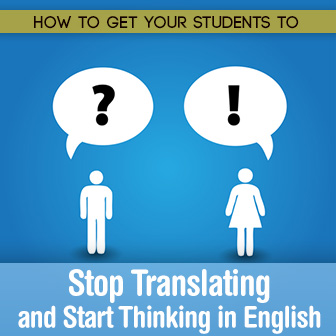“How do you say, ‘Que tengas un buen fin de semana’ in English?” How many times have your students asked you to translate something from or into their native language?
How often do you have students who translate things in their heads before answering you? By contrast, how often do you have students who provide a natural-sounding reply, spontaneously and automatically, without even blinking an eye? Chances are most of your students still translate in their heads – at least some of the time. Our goal as teachers is to guide students towards increasingly thinking in English and drop the crutch of translation. But we all know this is precisely one of the hardest things to achieve. So how do we do that? How can we effectively get our ESL students to think in English?

Why it’s so important for ESL students to stop translating and start thinking in English
- Consider their main goal. They want to learn to speak English, not become translators. There’s no point in them speaking their native language in their heads while they’re trying to learn another.
- It’s counterproductive. The constant comparison of one language to another hinders naturally flowing speech. Experienced interpreters are real pros at this, but your students are not.
- Some things are simply too hard to translate. This creates a situation where the student is desperately trying to remember how to say the one word they have in their minds in English, while they should be trying to recall a recent lesson instead.
Now, that we’ve established the importance of getting students to think in English for the duration of the class, let’s see ways to help them achieve this ever-elusive state.

How to Get YOUR Students to Stop Translating and Start Thinking in English
-
1
Use an English-English Dictionary
If you teach ESL by only speaking English in class, then you often supply definitions or explanations of words in English. Ask students to use Eng-Eng dictionaries, and it will contribute to your efforts.
-
2
Mime Feelings and Actions
When you teach feelings like “sad”, “happy”, “scared”, etc…it’s a lot simpler to translate them. But it’s so much more fun to act them out – for you and your class! The same goes for actions like opening closing things, walking, running, etc.
-
3
Teach Language in Context
A student a writes a word on the board, points to it and asks what it means. Most of the time we have no idea where they got it, which leads us to ask questions about the context. After all, there are plenty of words that have different meanings in different contexts. This is precisely why language must be taught in context. For example, would you teach the Past Simple by presenting a list of verbs and their past forms? What if there are verbs they don’t understand? Your best course of action is to introduce the context first. Tell students what you do every day, and then tell them what you did yesterday. This eliminates any need for translation.
-
4
Introduce Set Phrases as Set Phrases
Has a student ever asked you to translate the meaning of “You’re welcome”? In most languages a literal translation is ridiculous, but providing a similar phrase in the students’ native language is not necessary, either. When students ask for translation simply say a set phrase is a set phrase. Make sure they understand it’s a reply to “Thank you”. They will probably figure out the equivalent in their language, but with some expressions an equivalent is hard to come by – think of proverbs or idiomatic expressions. The goal is for them to understand the meaning of the phrase and when it’s used.
-
5
Use Visual Aids
Like miming, visual aids such as flashcards, illustrations, posters and even video are great ways to avoid translation.
-
6
Use Opposites or Synonyms
Use words they already know in lead in questions: Are you happy to see your friend? You’re glad to see him. Check out these other great ways to teach vocabulary. No translation needed at all!
-
7
Teach Language in Groups
The need for translation will be eliminated if you teach words in groups that make sense, for example, “eat” and “drink” with a list of food items.
-
8
Pretend You Don’t Understand
If students try to say things in their own language, simply say you don’t understand. Try to lead them to say what they want to say in English. This is by far my favorite strategy. If a student speaks to me in Spanish, I love to say, “Yo no hablar español” with a thick English accent (besides being absolutely fluent in Spanish, I’m also a good actress). Because it’s funny, it predisposes students better than a reprimand!
There is still much debate as to whether an ESL class should be English only or include some elements of the native language.
I have personally had excellent results speaking only English in my classrooms. There have been very few occasions in which I had to explain something to a student in Spanish, but those were very special cases or students with some type of learning difficulty. When I teach Japanese students, I can’t use their native language at all. I can’t speak a single word in Japanese, but that doesn’t impact the lesson negatively, in fact, it is very helpful, as students are not tempted to use their native tongue.
What is your take on this topic? Do you teach in an English-only classroom, or do you also speak students native language? I’d love to hear your thoughts on this!
P.S. If you enjoyed this article, please help spread it by clicking one of those sharing buttons below. And if you are interested in more, you should follow our Facebook page where we share more about creative, non-boring ways to teach English.







